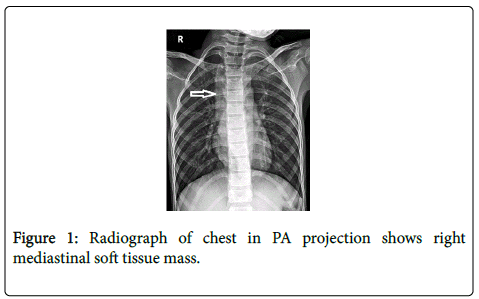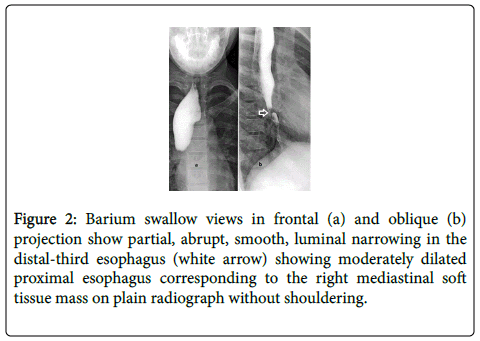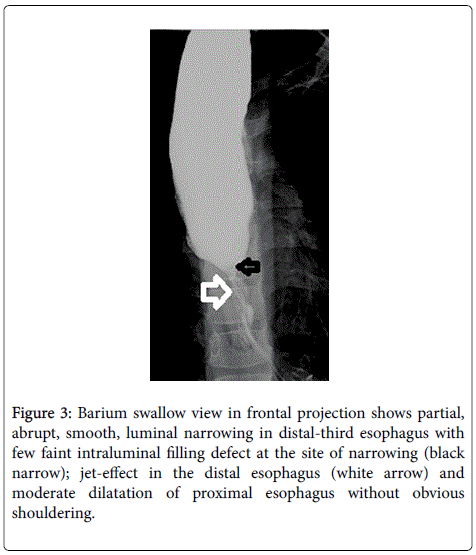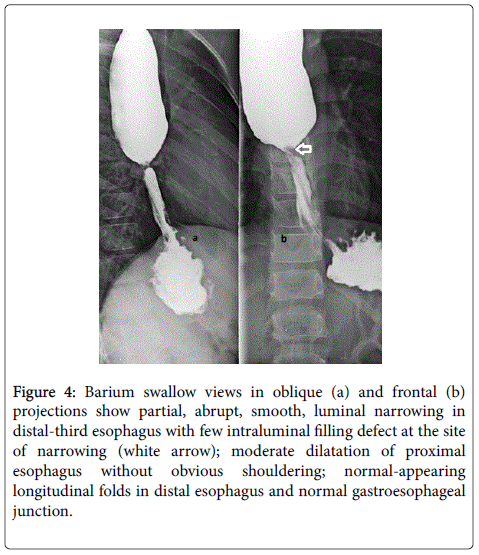Case Report Open Access
Congenital Esophageal Stenosis: A Rare Case of Childhood Dysphasia
Rajul Rastogi*, Asif Majid, Vijay Pratap Singh, Pawan Joon, and Yuktika Gupta
Teerthanker Mahaveer Medical College and Research Centre, Moradabad, Uttar Pradesh, India
- Corresponding Author:
- Dr. Rajul Rastogi
Assistant Professor, Department of Radiodiagnosis
Teerthanker Mahaveer Medical College and Research Center
Moradabad, Uttar Pradesh, India
Tel: 919319942162
E-mail: eesharastogi@gmail.com
Received Date: January 28, 2016; Accepted Date: February 04, 2016; Published Date: March 15, 2016
Citation: Rastogi R, Majid A, Singh VP, Joon P, Gupta Y (2016) Congenital Esophageal Stenosis: A Rare Case of Childhood Dysphasia. J Gastrointest Dig Syst 6:407. doi:10.4172/2161-069X.1000407
Copyright: © 2016 Rastogi R, et al. This is an open-access article distributed under the terms of the Creative Commons Attribution License, which permits unrestricted use, distribution, and reproduction in any medium, provided the original author and source are credited.
Visit for more related articles at Journal of Gastrointestinal & Digestive System
Abstract
Congenital esophageal stenosis (CES) is a rare cause of esophageal dysphagia. It is secondary to failure of complete separation of respiratory tract from primitive gut in early fetal life. Diagnosis may be delayed requiring high index of clinical suspicion and esophagogram studies. Final diagnosis of the subtype may require histopathological examination. Treatment may range from endoscopic dilatation in mild cases to esophageal resection in severe cases. In this article, we describe a rare case of congenital esophageal stenosis presenting in late childhood as dysphagia with characteristic barium esophagogram study. Very few cases have been reported in the medical literature in the past.
Keywords
Congenital; Stenosis; Dysphagia
Introduction
Congenital esophageal stenosis is a developmental anomaly occurring in approximately one out of 25,000-50,000 live births [1]. Fetal anoxia causing defective canalization of esophagus is a postulated mechanism [2]. Clinical presentation may range from dysphagia or recurrent vomiting/aspiration pneumonitis in early childhood to severe dysphagia, chest pain during deglutition or recurrent food impaction in early adulthood. Early diagnosis is the key to early management obviating the need for major esophageal surgery especially resection.
Case Report
An eleven-year old boy presented in our hospital outpatient department with a complaint of significant progressive dysphagia since last 2 years associated with regurgitation of food particles recently without history of significant weight loss or chest pain.
No history of dysphagia in early childhood or choking/respiratory symptoms could be elicited. There was no history of corrosive ingestion in the past. No history of any obvious abnormality is noted in antenatal fetal ultrasonographic examination. Laboratory tests were unremarkable. Chest radiograph revealed right mediastinal soft tissue mass with smooth lateral margin (Figure 1).
Barium swallow examination was then advised to look for the cause of dysphagia. Examination was performed under image intensifier and it revealed dilatation of proximal two-third esophagus (corresponding to right mediastinal soft tissue mass in chest radiograph) with shortsegment, circumferential narrowing in distal-third esophagus showing smooth margins without obvious signs of proximal shouldering or reflux esophagitis or hiatus hernia (Figure 2).
Figure 2: Barium swallow views in frontal (a) and oblique (b) projection show partial, abrupt, smooth, luminal narrowing in the distal-third esophagus (white arrow) showing moderately dilated proximal esophagus corresponding to the right mediastinal soft tissue mass on plain radiograph without shouldering.
Evidence of irregular filling defect was noted at the site of stricture associated with eccentric jet-effect (Figure 3) and fairly-preserved longitudinal mucosal folds in the normal-appearing distal esophagus and morphologically normal gastro-esophageal junction (Figure 4).
Figure 3: Barium swallow view in frontal projection shows partial, abrupt, smooth, luminal narrowing in distal-third esophagus with few faint intraluminal filling defect at the site of narrowing (black narrow); jet-effect in the distal esophagus (white arrow) and moderate dilatation of proximal esophagus without obvious shouldering.
Figure 4: Barium swallow views in oblique (a) and frontal (b) projections show partial, abrupt, smooth, luminal narrowing in distal-third esophagus with few intraluminal filling defect at the site of narrowing (white arrow); moderate dilatation of proximal esophagus without obvious shouldering; normal-appearing longitudinal folds in distal esophagus and normal gastroesophageal junction.
Esophageal emptying was delayed with proximal hold-up of contrast in esophageal lumen for up to 60 minutes associated with slight oral regurgitation of barium.
Based on the above findings a radiological diagnosis of partial, congenital esophageal stenoses probably secondary to esophageal web was suggested. Esophageal endoscopy confirmed the diagnosis of esophageal web which was treated with endoscopic dilatation and resection of web. The irregular filling defect noted at the site of stenosis on barium esophagogram was due to food particles admixed with desquamated mucosa. No evidence of any obvious signs of malignancy was noted.
Discussion
Congenital esophageal stenosis may exist in one of the following three forms [2]:
• Thin esophageal membrane or web comprising of normal mucosa and submucosa,
• Fibromuscular stenosis caused by fibrotic changes in submucosa and muscularis propria, and
• Tracheobronchial remnants characterized by presence of cartilage, tracheal glands and respiratory epithelium.
CES secondary to tracheobronchial remnants is commonest involving preferentially lower-third esophagus while those secondary to web/membrane and fibromuscular etiologies are more common in the middle-third part of esophagus [3]. In general, higher stenoses present commonly with respiratory symptoms while lower ones present commonly with vomiting.
Esophageal web or membrane is 1-2 mm thick, shelf-like structure made of normal esophageal mucosa and submucosa causing partial or complete luminal obstruction showing central or eccentric orifice.
Though symptoms secondary to CES may start around the weaning period during infancy with dysphagia to solids yet in many cases minor degrees of stenosis is often overlooked, seeking medical attention only in young adulthood due to major food impaction or regurgitation [4]. Despite a long history of dysphagia, a high-clinical suspicion with characteristic esophagogram serves as clues for early diagnosis. Final diagnosis may require tissue examination in most cases as CES secondary to tracheobronchial remnants is the commonest etiology [5]. About one-third cases of CES may be associated with esophageal atresia [6,7].
Esophagogram in CES characteristically reveals short-segment, circumferential luminal narrowing in upper, middle or lower-third part of esophagus with smooth and tapering margins associated with proximal dilatation without obvious signs of shouldering [4,5]. However, normal esophagogram may be noted in initial cases while signs of reflux esophagitis may be noted in cases of lower-third involvement.
Multiple cases of CES in various forms have been reported in the literature especially tracheobronchial type [1-4,6-8] but very few cases secondary to esophageal web especially in late childhood had been reported in medical literature in the past [9-11].
Puntis et al. described a case of esophageal web causing dysphagia in young child involving the postcricoid region [9]. CES secondary to esophageal web may require luminal dilatation with endoscopic resection or laser division as luminal dilatation alone is associated with recurrence [10]. Altamimi also reported a case of childhood dysphagia caused by esophageal web in upper esophagus [11]. Thus our index case is not only rare but is unique in the fact that it involves lower-third esophagus.
In addition to CES, differential diagnosis of esophageal stricture includes the following:
• Reflux esophagitis usually seen with lower-level stenosis causing gastroesophageal reflux showing lack of distensibility with or without transverse/converging, thickened folds secondary to inflammation,
• Achalasia which is rare in infants and children involving the esophagogastric junction showing a long, tapered, narrow segment resembling a “bird’s beak” with disorganized peristalsis,
• Vascular ring due to double aortic arch seen as smooth posterior compression of middle-third esophagus unaffected by peristalsis and
• Esophageal neoplasm, very rare in infants causing asymmetric, irregular and abrupt stricture.
Conclusion
Congenital esophageal stenosis is a rare cause of childhood dysphagia occurring in various forms. Barium esophagogram plays a central role in diagnosis. Early diagnosis is very crucial for early management that may avoid surgical esophageal resection, reducing morbidity and mortality significantly in CES patients. Thus, CES should be strongly suspected as a cause of dysphagia in childhood and young adults.
References
- Murphy SG, Yazbeck S, Russo P (1995) Isolated congenital esophageal stenosis. J PediatrSurg 30:1238-1241.
- Oh CH, Levine MS, Katzka DA, Rubesin SE, Pinheiro LW, et al. (2001) Congenital esophageal stenosis in adults: Clinical and Radiographic findings in seven patients. AJR 176: 1179-1182.
- Ramesh JC, Ramanujam TM, Jayaram G (2001) Congenital Esophageal Stenosis: report of three cases, literature review, and a proposed classification. Pediatr Surg Int 17:188-192.
- Pokieser P, Schima W, Schober E, Böhm P, Stacher G, et al. (1998) Congenital Esophageal Stenosis in a 21-Year-Old Man: Clinical and Radiographic Findings. AJR 170:147-148.
- Ibrahim AH, Malki TA, Hamza AF, Bahnassy AF (2007) Congenital Esophageal Stenosis associated with esophageal atresia: new concepts. PediatrSurgInt 23:533-537.
- Zhao LL, Hsieh WS, Taipei WM (2004) Congenital Esophageal Stenosis Owing to Ectopic Tracheobronchial Remnants. Journal of Pediatric Surgery 39: 1183-1187.
- Amae S (2003) Clinical Characteristics and Management of Congenital Esophageal Stenosis: A Report on 14 Cases. Journal of Pediatric Surgery 38: 565-570.
- Serrao E, Santos A, Gaivao A, Tavares A, Ferreira S (2010) Congenital esophageal stenosis: a rare case of dysphagia. JRadiol Case Rep 4: 8-14.
- Puntis JW, Chapman S, Proops DW, Sartori P (1989) Dysphagia due to esophageal web. Arch Dis Child 64:141-143.
- Roy GT, Cohen RC, Williams SJ (1996) Endoscopic laser division of an esophageal web in a child. J Pediatr Surg 31: 439.
- Altamimi E (2015) Esophageal web in a child. International Journal of Clinical and Medical Imaging 2: 1000354.
Relevant Topics
- Constipation
- Digestive Enzymes
- Endoscopy
- Epigastric Pain
- Gall Bladder
- Gastric Cancer
- Gastrointestinal Bleeding
- Gastrointestinal Hormones
- Gastrointestinal Infections
- Gastrointestinal Inflammation
- Gastrointestinal Pathology
- Gastrointestinal Pharmacology
- Gastrointestinal Radiology
- Gastrointestinal Surgery
- Gastrointestinal Tuberculosis
- GIST Sarcoma
- Intestinal Blockage
- Pancreas
- Salivary Glands
- Stomach Bloating
- Stomach Cramps
- Stomach Disorders
- Stomach Ulcer
Recommended Journals
Article Tools
Article Usage
- Total views: 13722
- [From(publication date):
April-2016 - Apr 05, 2025] - Breakdown by view type
- HTML page views : 12776
- PDF downloads : 946




